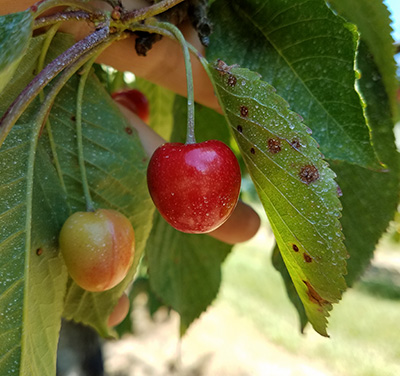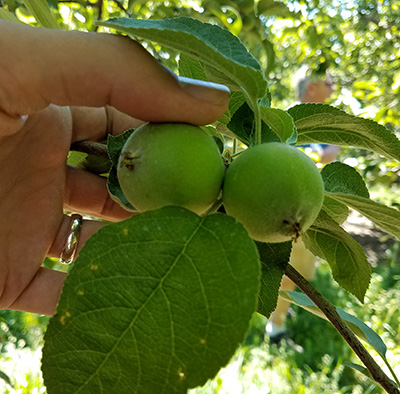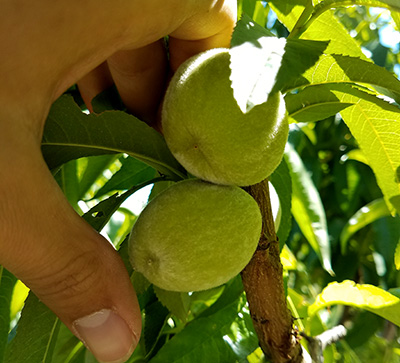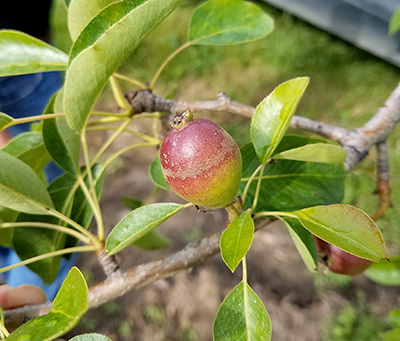West central Michigan tree fruit update – June 20, 2017
Update on growing degree-days, frost damage, tree fruit developmental stages, fungal diseases and insect pests for the tree fruit industry in west central Michigan.

Weather report
Rainy weather over the past 10 days in west central Michigan has resulted in some much needed precipitation accumulation. Most west central Michigan State University Enviroweather stations accumulated at least an inch in the past week. This rain has been coupled with warm, sunny afternoons and temperatures in the high 70s and low 80s.
Tree fruit has responded to this period of rain, sun and warmth with rapid sizing across the region. However, the sporadic and frequent nature of the rainfall in the past 10 days has led to significant problems with disease management for growers throughout the region.
|
Growing degree-days (GDD) since Jan. 1 and rainfall accumulation since June 13. | ||||
|---|---|---|---|---|
|
Enviroweather station |
GDD base 42 current |
GDD base 45 current |
GDD base 50 current |
Rainfall since June 13 (inches) |
|
1,025 |
813 |
525 |
1.43 |
|
|
1,210 |
990 |
679 |
1.43 |
|
|
1,317 |
1,086 |
760 |
0.97 |
|
|
1,204 |
981 |
669 |
0.83 |
|
|
1,159 |
941 |
638 |
1.32 |
|
Crop report
Tart cherries are between 15-20 millimeters and are starting to show yellow and pink color. Harvest in the earliest areas of west central Michigan is currently being estimated to begin in the first week of July. The crop is lighter, but most blocks in the region still have a percentage of fruit that will be harvested this season.
Sweet cherry harvest will begin within a week to 10 days at several locations in the region. Fruit are sizing rapidly and gaining color. Fruits are between 20 and 25 millimeters.

Sweet cherries in Hart, Michigan, on June 20.
Apples are generally looking better than originally forecasted in the region. Side blossoms that opened after the May freeze events opened and set fruits, leading to better than expected crop loads in many areas. Most blocks have at least a light crop, though there are some that are empty.
Fruits are 25-30 millimeters and sizing has been rapid. In addition to the rain and warm weather, the reduced crop load has likely contributed to this rapid fruit sizing.

McIntosh apples in Shelby, Michigan, on June 20.
Peaches are 25-30 millimeters throughout the region, and the crop is spotty. Many sites have a nice crop coming on and others are nearly empty.

Vinegold peaches in New Era, Michigan, on June 20.
The effects of the frost continue to be noticed, particularly on apples and pears. Frost rings and scarring have become increasingly evident on many farms, with many growers weighing their options with damaged fruit.

Frost ring on Bartlett pear in Shelby, Michigan, on June 19.
Pest report
Cherry leaf spot continues to be a concern throughout the region. There have been five full progress towards infection periods in the past 6 days due to the rain and warm weather. Coverage was challenging last week due to the sporadic and often unpredictable rains. Growers continue to observe active lesions, so managing tart cherries already displaying visible symptoms has been a point of emphasis over the past several days.
Growers looking to adequately rotate fungicide modes of action to manage for resistance should review the table of fungicides registered for the management of cherry leaf spot, included below.
|
Class of chemistry and fungicides registered for cherry leaf spot control | |
|---|---|
|
Chemistry |
Fungicide |
|
Sterol-inhibitors (SIs) |
Elite, Indar, Nova, Rubigana |
|
Strobilurins |
Gem, Pristineb |
|
Mixture (strobilurins plus SI) |
Adament |
|
Guanidine |
Syllit (dodine) |
|
Heterocyclic |
Captanc |
|
Inorganic metal ion |
Copper |
Source: George Sundin, Michigan State University
a Because of widespread resistance in Michigan, SIs should never be used alone and are not recommended for leaf spot control.
b Pristine is a mixture of a strobilurin and boscalid, another fungicide (separate chemistry).=
c Captan should only be used in combination with other fungicides because the rate (2.5 pounds per acre Captan 80WDG) allowed on cherries is too low for effective disease control.
Primary apple scab is now over in west central Michigan. However, growers with active scab in blocks still need to be covering for scab for another three to four weeks until fruits are no longer susceptible. Generally, this is a light year for scab in the region thus far, with lesions and sporulation mostly limited to the second and third fully expanded leaves on susceptible cultivars such as McIntosh.
Fire blight damage also continues to be minimal throughout the region, mostly relegated to isolated trees in highly susceptible cultivars such as Gala, Rhode Island Greening and Idared. Much of what is being suspected as fire blight this season has actually been nectria twig blight, a disease of typically minimal significance in the apple industry with no recommended management strategy.
Management spotted wing Drosophila (SWD) has begun in the region in all cherry blocks exhibiting straw, pink or red color. All 10 townships that are included in the MSU SWD trapping network have caught at least one SWD at this time, indicating this pest is active throughout the region and should be considered at threat to susceptible fruit.
All sweet cherries in the region are susceptible to SWD given current developmental stages, and many blocks of tart cherries are susceptible as they begin turning yellow and pink. SWD can attack any cherry fruits that have developed yellow or pink color; manage appropriately.
Codling moth trap counts are increasing throughout the area, with a current regional biofix estimate of May 18. San Jose scale crawlers are being observed in isolated locations, mostly in blocks with a history of issues with the pest. The first flight of oriental fruit moth has largely ended, so growers are now scouting for shoot flagging caused by the larvae that hatched from eggs laid on terminal shoots during the first generation flight. Pear psylla adults are now active in pear blocks.



 Print
Print Email
Email

